In fact to say if you were to trace the origins of Vietnamese where history is of concern, just perhaps you can say that Vietnamese were originally Cantonese. Both the Cantonese and Vietnamese were the decendents of the once all great Nan Yue Kingdom ( 南越国 Nàahm-yuht in Cantonese, Nam Viet in Vietnamese)
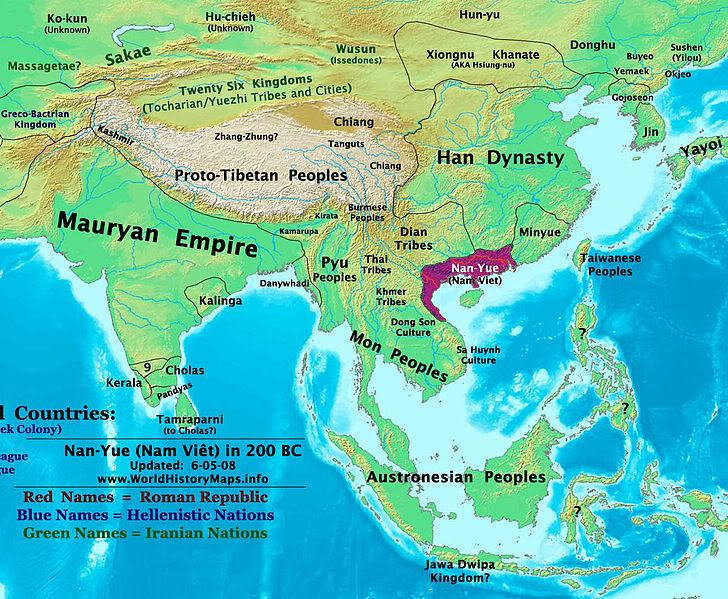
The Language of Vietnamese is very similiar to the Cantonese Dialect of the Chinese. Assuming that you do not understannd both, it is almost most certain that you will definately think that both are same with no difference at all.
Yo may want to take a look a the videos below to see if it is convinencing enough
Lunar New Year
Typically and commonly known by most people as the Chinese Calendar. The Chinese New Year is based on the Lunar Calendar.
Those who celebrate this New Year is definately just the Chinese alone. Among those who celebrate this same festival alongside with the Chinese are the Koreans, Vietnamese, Mongolians and Tibetians. In fact the Japanese before World War 2, celebrated the exact same new year as the Chinese as well. But since plans of invasion, they had somewhat stopped celebrating this festival and instead had their own new year shifted to be on January 1st have it to be the same as the Western New Year, to be the same as the Western calendar or the so called Gregorian calendar.
The Lunar New Year are known as the following by the different groups of people
1) Chinese New Year – 春節 (Pinyin: Chūnjié)
2) Koreans NewYear – Seollal (Hangul: 설날; RR: Seollal; MR: Sŏllal)
3) Vietnamese New Year – Tết Nguyên Đán
4) Mongolian New Year – Tsagaan Sar (Mongolian: Цагаан сар ᠴᠠᠭᠠᠨ ᠰᠠᠷᠠ )
5) Tibetan New Year – Losar (Tibetan: ལོ་གསརWylie: lo-gsar; Chinese: 洛薩)
6) Japanese New Year – Shōgatsu (正月)
Vietnamese New Year (Tết Nguyên Đán)
Vietnamese New Year does shares much similiarities with Chinese new year as they share too much with that of the Chinese. But however, they do have some elements of their own versions with slight differences.
While Chinese New Year is 15 days of Celebration and if to include the eve, it will be a 16 days of celebration, Vietnamese new year on the other hand is also a 15 days of celebrations and if to include in the eve and before eve, it will be a 19 days of celebrations.
There are 3 part of it. Before the Eve, the Eve itself and then New Year
19 Days of New Year
The below will be on what it is like on the 15 days of new year.
Before eve : .Ông Công, Ông Táo Day (Kitchen God day)
Before Eve : Wrapping Chung cake
Before Eve : Family reunion and Tất niên
Eve ( Giao thừa) : Decorations, Be Debt Free, Cooking Traditional Food and Shopping all neccessarities ( including praying sessions to God and Ancestors )
Day 1-3 : First three days of the new year: visit paternal side on the first day, maternal side on the second day and teachers on the third day
Day 4-6 : Visit relatives, friends and neighbours
Day 4 : Hóa vàng - burn the offerings near Tet's end for ancestors
Day ??: Reopen business: usually owners pick a good date that matches their age
Day 15 : Tết Nguyên Tiêu – Latern Festival also known as Valentine's Day
Kitchen God Day ( Ông Công, Ông Táo)
On the day of Kitchen God, it is a very imnportant day for the vietnamese. This is because they would want to have good reports by the Kitchen Gods to the Jade Emperor. There are 3 Kitchen Gods in total. 2 are men and 1 is woman. The 3 of them will be giving the annual report of each family to the Jade Emperor and the Jade Emperor will decided to bless or punish this family in terms of luck and prosperity for the coming year.
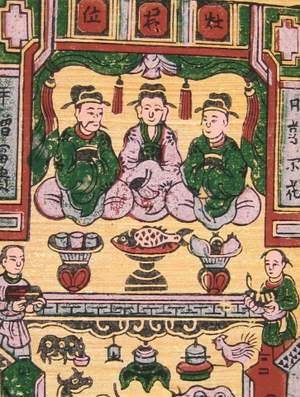
Family members will make delicacies from the newly harvested sticky rice, like steamed sticky rice accompanied by sugar porridge and sticky rice cookies shaped like cones. Incense sticks are lighted up and fresh flowers are used for the worshipping ceremony

In order for them to reach the heavens, they would need the help of the golden carps as carps are the animals of the heavens and that they are very good swimmers. Hence, to show humans respects and gratitute for nature , Vietnamese would free the carps into ponds, rivers or lake so that can take the kitchen gods to heaven and deliver their reports to the Jade Emperor.
The 2nd day before the Eve
This is the day that most people will be busy preparing and wrapping Chung cake which is part of their traditions.
The Legend of Chung ( Rice Cake)
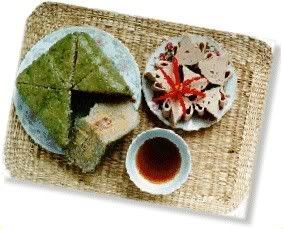
it was in the legend that King Hung Vuong VI issued out a challeged to his 22 sons to determine who would inherit the throne where which each of his sons were to come out with the best food for Tet (New Year).
All of the princes went far and wide for the most exotic dishes to present to their father but except for one, the 18th prince, Lang Lieu who was the shyest and kindest and at the same time the poorest of them all, whom created a dish using simple ingredients baed on what a genie had told him in a dream.
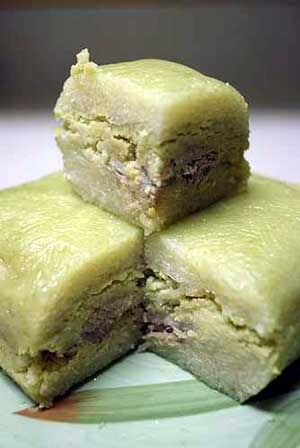
The prince did exactly as per instructed by the genie of his dream to prepare and make this extraordinary dish.
After the King ate the dish prepared by him, the king was ecstatic and proclaimed his throne to this 18th son of his, Prince Lang Lieu.
After the King has learn of his dream, the king was futher convienced that this cake were blessed cakes because of celestial connections and had order that the recipe to be shared with all commoners and with thanks to that royal decree of that time, Banh Chung is today an official Tet Food

Equiptment used for making Banh Chung
Wooden Frame
16 dried bamboo leaves
12 pieces green banana leaf (or frozen and thawed), trimmed, rinsed, and wiped dry
16 pieces of kitchen twine, cut into 20" lengths (additional needed if used for cutting)
kitchen shears
4 sheets of heavy-duty aluminium foil, cut in 30x45 cm (12" x 18") sheets
Chinese double steamer
Parchment paper
Food processor
Deep stockpot for boiling cakes
Plastic wrap
Ingredients of Banh Chung :
1280 ml (5 1/4 cups) long-grain sticky rice (soaked overnight and drained before assembly)
1 415 ml (14-oz) can of coconut juice (NB: not coconut cream)
1 1/2 tablespoon sea salt
Cold water
640 ml (2 2/3 cup) dried, hulled, and split yellow mung beans (soaked overnight and drained before assembly)
cold water
1 570 gm (1/4 lb.) boneless pork chop (or pork butt), with some skin and fat
1 medium-sized Vidalia or Spanish onion, minced
3 tablespoons of sea salt
3 teaspoons black pepper, freshly ground
1 tablespoon sugar
1 tablespoon canola oil or other neutral oil (if frying cakes)

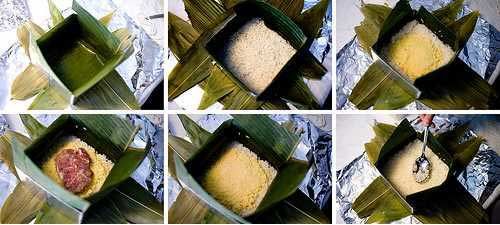
You may want to watch the video on the preparing and making of this Rice Cake
Eve of New Year
On this last day of new year, People are most busy. There are plenty of things to do. There is alot last minute shoppings to do as well.
Just like the Chinese they will do their own spring cleaning to keep their house clean throughly.
After they are done with the cleaning it will be time for lots of decorations.
Followed it will the most scared of them all which is to clean , rearrange ,tidy and the setting up of their own ancestor altar. The mam ngu qua ( 5 Fruit Tray) is most important.
Man Ngu Qua ( 5 Fruit Tray)
The Chinese had always believe in a balance and the 5 elements which are Metal, Wood, Water, Fire and Earth. The 5 fruits are both a symbolic representations by the 5 elements as well as the hard work of the family throughout the past being consecrated to heaven and earth and their ancestors as a sign of respect and gratitude.
The 5 fruits in the northern area of Vietnam would be pomelos, peaches, kumquats, bananas and persimmons
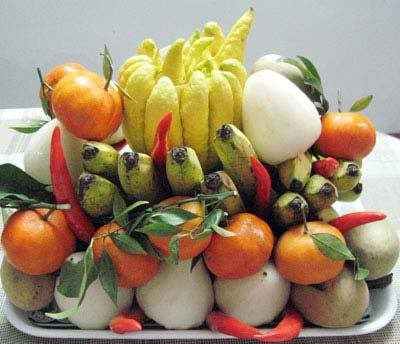

Wherelse in the southen area of Vietnam it would be watermelons, coconuts, papayas, custard apples, mangos, and figs
Whichever 5 combination it is, both the north and the south 5 fruit tray is an offering to the ancestors by the Vietnamese people. It displays a life-long tradition but also sends a message of hope for happiness, good luck and prosperity for the new year.
After they are done with their ancestors, it would be time for a gathering and meal among family members
It was also a good time to watch TV shows and doing the count down together.
Tết Nguyên Tiêu – Latern Festival also known as Valentine's Day
Very much alike to the Chinese, this is a valentie day. This is a day of prayers and visiting of pagodas, watching the full moon, and playing with laterns.
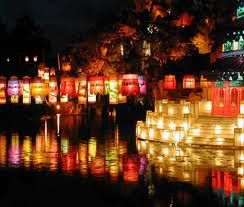
During the Celebration of Tết Nguyên Đán
Pretty much similiar and alike to the Chinese in many ways, Vietnamese also believe in being Debt free before the new year and having spring cleaning.
Family reunion dinners and gathering are also another similiarity.
Whatever that can change to something new should be changed such as old furnitures etc....
It is also very important to wear total new clothes on the beginning of the new year just like the Chinese.
Clothes of Bright colours such as Yellow and Red is to be worn. No dull ,dark, unlucky colours are to be worn on this day of new year.
During visiting on Lunar new year, for the Chinese, the elder and married would give away Red Envolpes / Packets ( Hong Baos) to the Children and those who are single as a form of blessing and to ward off bad luck with some money inside.
To the Vietnamese, it is known as Lì Xì or lucky money
Do also take note that the amount of money given must only be in even numbers and cannot be in odd numbers.
Nice words of wishes and blessing will be said to each other on this day and it is a time of lots of fun and gathering with much eating and drinking.
I suspected my wife of cheating on me but I never had any proof. This went on for months, I didn't know what to do. i was so paranoid and decided to find a solution, i saw a recommendation about a PI/Hacker and decided to contact him. I explained the situation about my wife to him and he said he was going to help me.I gave him all the informations he required and afterwards i oo received all my wife’s phones Text messages and calls, I was hurt when i saw a picture of my wife and her lover. I feel so bad about infidelity. but i am glad Mr james was able to help me get all this information, you can contact him through Gmail : (Worldcyberhackers) or WhatsApp : +12678773020 if you need help, infidelity hurts
ReplyDelete